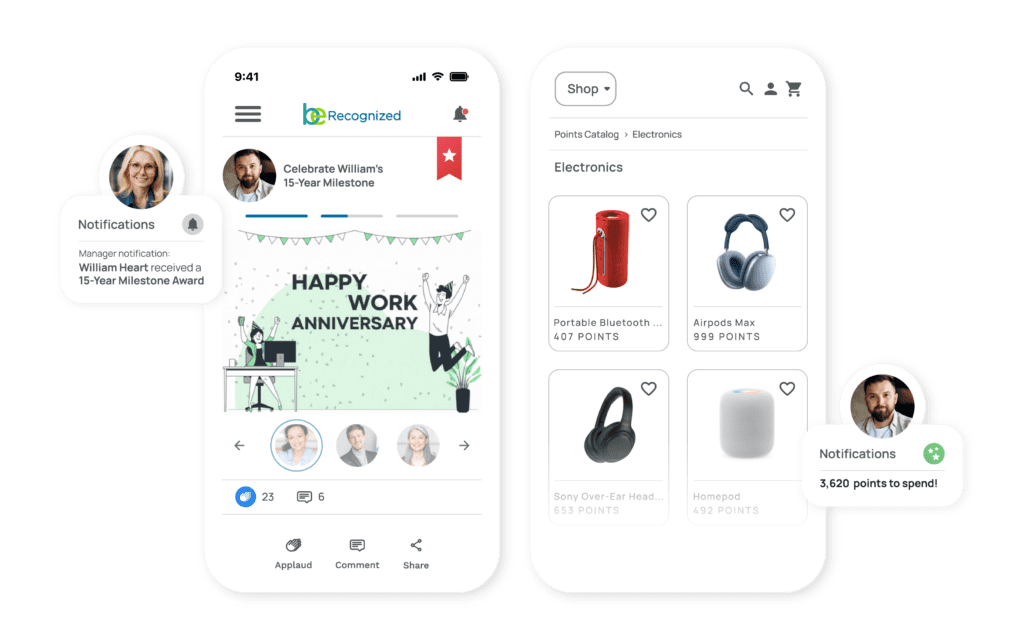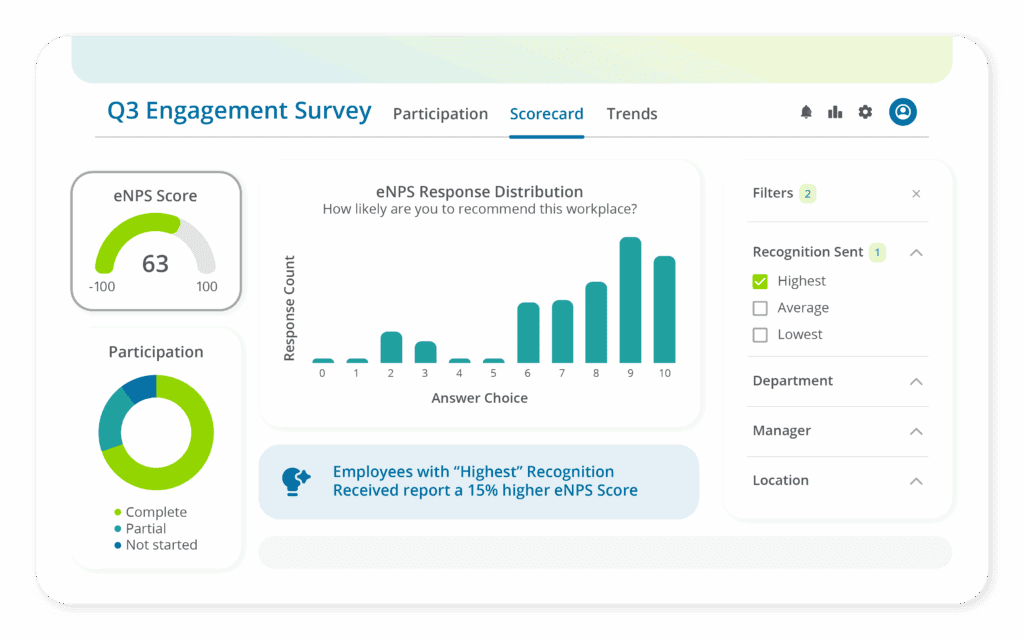October 8, 2025

Discover the key drivers of employee engagement and learn how to enhance productivity and morale in your organization. This article breaks down the critical factors that can make your workforce more committed and motivated.
Key Takeaways
- Employee engagement is driven by emotional connections, psychological safety, and clear communication, ultimately enhancing productivity and loyalty.
- Key drivers of employee engagement include recognition, professional development, empowerment, and a focus on meaningful work, all of which boost morale and retention.
- Organizations that prioritize inclusivity, positive leadership, work-life balance, and psychological safety create a vibrant and engaged workforce, crucial for long-term success.
Understanding Employee Engagement
Employee engagement refers to the emotional and psychological connection between employees and their work. It also encompasses the employee-manager relationship they have with their employers. This connection goes beyond just job satisfaction; it involves a deep sense of purpose, creativity, and ownership.
When employees are engaged, they exhibit an emotional investment in their work, finding purpose and commitment to their organization. This emotional engagement is what truly drives productivity, motivation, and overall success for organizations, reflecting how the employee feels about their role and employee sentiment.
Creating a work environment where employees feel safe is fundamental to fostering engagement. Psychological safety leads to a more innovative and productive workforce because it allows employees to take risks and express their ideas without fear of negative consequences.
Engaged employees are also more likely to feel motivated and loyal, reducing turnover rates and enhancing overall job satisfaction.
Distinguishing employee engagement from mere happiness is crucial. While happiness might reflect short-term satisfaction, engagement is about long-term commitment and emotional investment.
Engaged employees are less likely to leave, more likely to recommend the organization, and generally contribute to a positive work environment. Understanding these nuances is crucial for developing effective employee engagement strategies.
The Importance of Employee Engagement Drivers
Identifying the key drivers of employee engagement is key to enhancing productivity and profitability. Research shows that high employee engagement can lead to organizations being 20% more productive and 20% more profitable. Furthermore, companies in the top quartile for employee engagement experience an average growth rate of 9.7%.
Analyzing these key drivers of employee engagement enables the development of an actionable employee engagement strategy that can drive engagement, enhance employee satisfaction, and boost productivity.
Key factors that enhance engagement include:
- Leaders being genuinely passionate about their work, inspiring similar enthusiasm in their teams.
- Having committed coworkers fosters a culture of engagement and enhances group collaboration.
- A collaborative environment that encourages employees to take initiative and contribute ideas, further enhancing overall engagement. Senior leadership plays a crucial role in this process.
Highly engaged employees drive innovation and deliver better results, and are ultimately more invested in the company’s success. Therefore, fostering a culture of engagement is not just beneficial but essential for achieving long-term organizational success.
10 Key Drivers of Employee Engagement
Employee engagement directly influences productivity, retention, and business performance. According to Gallup, highly engaged teams show 21% greater profitability and 59% lower turnover.
Understanding what drives engagement can help organizations create environments where employees are motivated, committed, and aligned with company goals.
1. Clear Communication Channels
Transparent, consistent communication is the foundation of engagement. Gallup research shows that employees who receive regular updates from leadership are 3x more likely to feel engaged at work.
Open, two-way communication builds trust and inclusion, ensuring employees feel informed and heard. Regular feedback loops—where employee input is acknowledged and acted upon—are proven to improve engagement and performance outcomes.
Utilizing multiple communication platforms helps maintain alignment across hybrid and global teams. Consistent messaging reduces confusion and builds organizational trust, both of which are essential for sustaining engagement and productivity.
Consistent and transparent communication channels are vital for maintaining engagement. This approach not only improves employee engagement but also enhances customer satisfaction by ensuring that everyone in the organization is on the same page.
2. Recognition and Rewards
Employee recognition is one of the most powerful engagement levers. A Deloitte study found that organizations with strong recognition programs have 31% lower voluntary turnover and 12x higher business outcomes than those without.
Effective recognition programs should:
- Align with organizational values and reinforce desired behaviors.
- Highlight both individual and team achievements.
- Include recognition from peers and leaders to amplify impact.
Modern recognition platforms, like Terryberry's Be Recognized platform, make it easier to acknowledge employee success in real time, regardless of location. Plus, rewards—such as merchandise, charitable giving, or experiences—combined with authentic appreciation create a culture where employees feel seen and valued, driving loyalty and long-term engagement.
Frequent recognition, ideally every week, helps highlight success stories and reinforce employees’ achievements and values within the company, contributing to employee retention. To further enhance this environment, it is essential to encourage employees and focus on inspiring employees.
3. Professional Development Opportunities
Professional development opportunities play a vital role in fostering employee engagement within the employee lifecycle:
- Nearly 90% of millennials view opportunities for career growth and professional development as very important.
- 94% of employees would stay with a company if it invested in their career development, contributing to the company’s success.
- Lack of opportunities for advancement is a top reason for workers quitting their jobs, and it’s crucial that employees understand this. When employees thrive, they are more likely to remain engaged and committed.
Mentorship programs can significantly aid in professional growth and engagement. Training and development programs, mentoring, and cross-functional projects help create opportunities for employee growth.
Prioritizing employee development fosters loyalty and enhances engagement. Aligning personal career goals with organizational objectives fosters a sense of commitment. Additionally, leadership development programs boost overall job satisfaction.
Continuous learning encourages employees to flourish and innovate. Offering regular constructive feedback enables employees to identify areas for improvement and take charge of their growth. Growth opportunities support employee confidence, commitment, and engagement, making them more likely to stay with the organization and contribute to its success.
4. Empowerment and Autonomy
Empowering employees and granting them autonomy is essential for increasing ownership, motivation, and productivity. Employee empowerment enhances a sense of ownership, creativity, and engagement, enabling employees to take control of their tasks and workflows.
When employees are trusted to make decisions about their work, they are more likely to exhibit innovation and engagement.
According to Harvard Business Review, employees who feel trusted and empowered are 67% more engaged than those who don’t.
When leaders delegate decision-making authority and encourage ownership, employees develop a deeper sense of accountability and motivation. Autonomy also supports innovation by giving employees freedom to experiment and improve processes.
Empowered teams consistently report higher satisfaction, stronger collaboration, and greater productivity—demonstrating that trust is a key driver of engagement.
An organizational culture rooted in trust enhances employee autonomy, leading to greater efficiency and innovation. Self-directed professional development opportunities empower employees to take charge of their growth and career paths.
A positive organizational culture empowers employees to take ownership and drive innovation. This approach leads to a more engaged and motivated workforce without the need for constant supervision, fostering a strong company culture.
5. Meaningful Work and Purpose
Meaning and purpose are among the most significant predictors of engagement and retention. A PwC study revealed that 79% of business leaders believe purpose is essential to success, and 90% of employees would trade some pay for more meaningful work.
Setting a shared vision allows employees to feel connected to organizational goals. Leadership communication on mission, vision, and long-term goals is necessary to align individual roles with organizational objectives.
By connecting work to the organization’s larger mission and vision, leaders help employees find purpose in their work. Highlighting individual contributions boosts a shared sense of purpose within the organization.
Employees who discover purpose in their work tend to be more engaged. This, in turn, increases their motivation. Valuing meaningful work is essential for enhancing engagement and job satisfaction.
6. Work-Life Balance
Flexible work arrangements, such as hybrid and remote workplaces, remote work options, and flexible schedules, contribute to improved employee well-being and higher job satisfaction.
Organizations that prioritize work-life balance and support flexible arrangements often experience significant boosts in productivity and employee engagement.
Implementing employee wellness programs that support physical and mental health is crucial in fostering a balanced work environment. These programs can include:
- Mental health days
- Fitness classes
- Stress management workshops By prioritizing employee well-being, organizations can create a positive work environment that encourages engagement and productivity.
Employees who feel valued and supported in their work-life balance are more likely to be engaged and motivated. Employees tend to prioritize work-life balance, which is key to improving engagement and job satisfaction.
7. Positive Leadership
Positive leadership is another factor that boosts employee motivation and engagement. Both employees and leaders share the responsibility of fostering employee engagement. It is a collaborative effort that requires participation from both parties.
Effective leadership has the power to create a positive work environment and drive employee engagement by promoting a positive employee experience and positive relationships.
Trust in management greatly enhances employee engagement. Employees develop trust in leadership through:
- Witnessing consistent, ethical behavior and good decision-making.
- Regular check-ins between managers and employees that create a sense of connection and accountability.
- Open and transparent communication that fosters trust, respect, and alignment with the company’s vision.
Supportive management is crucial for promoting a culture of care within the organization. Leaders who communicate transparently build trust and encourage employee feedback, enhancing overall engagement and job satisfaction.
8. Inclusivity and Diversity
Promoting an inclusive and diverse workplace creates psychologically safe, equitable, and inclusive conditions for employees. Key points include:
- 88% of employers view diversity and inclusion initiatives as critical, influencing their overall success.
- Diverse teams are 70% more likely to access new markets.
- This access drives innovation and operational success.
Organizations that prioritize diversity and inclusion are more adept at making innovative decisions. Companies with higher racial and ethnic diversity are statistically more likely to outperform their competitors.
Inclusivity and diversity foster a positive work environment where employees feel valued and respected, enhancing overall engagement and job satisfaction. Creating a culture of mutual respect and understanding is essential for fostering a diverse and inclusive workplace.
By involving employees in diversity and inclusion initiatives, organizations can create a more engaged and motivated workforce. Prioritizing inclusivity and diversity significantly enhances engagement and organizational success.
9. Psychological Safety
Psychological safety allows employees to share ideas without fear. Employees feel safe when they are able to voice opinions without negative consequences. Psychological safety encourages employees to take risks, experiment, and learn from their mistakes.
Creating an environment of psychological safety allows employees to express their authentic selves without fear of embarrassment. Key points include:
- Leaders play a crucial role in fostering psychological safety by encouraging open dialogue and accepting constructive feedback.
- High levels of psychological safety correlate with improved team performance and lower conflict rates.
Organizations with diverse perspectives thrive when psychological safety is prioritized, leading to enhanced problem-solving capabilities.
10. Leveraging Technology for Engagement
Leveraging technology is essential for enhancing employee engagement in today’s digital age. A survey revealed that 91% of workers consider high-quality digital tools vital for engagement.
Digital tools enhance internal communication, making collaboration between teams more effective. Using video conferencing and messaging apps can help remote workers feel included and informed.
Task management software offers several benefits:
- Allows employees to work flexibly, which can improve overall job satisfaction.
- Provides accessibility in technological tools to help prevent disengagement by removing barriers for employees.
- Includes gamified tasks that can increase motivation and enhance team bonding among employees.
By leveraging technology, organizations can create a more engaged and motivated workforce. Digital tools can enhance communication, collaboration, and overall engagement, leading to better business outcomes. Incorporating technology into engagement strategies is key to enhancing job satisfaction and organizational success.
Summary
Employee engagement is a multifaceted concept that requires a comprehensive approach. From clear communication and recognition to professional development and empowerment, each driver plays a crucial role in fostering a more engaged workforce.
Leaders must prioritize creating a positive work environment that values inclusivity, diversity, and psychological safety. By doing so, organizations can significantly boost morale, productivity, and overall job satisfaction.
In conclusion, understanding and implementing these key drivers of employee engagement can transform your organization. By measuring engagement, leveraging technology, and continuously acting on feedback, you can create a thriving workplace where employees feel valued and motivated.
Start today by adopting these strategies, and watch as your organization thrives with a more engaged and committed workforce.


